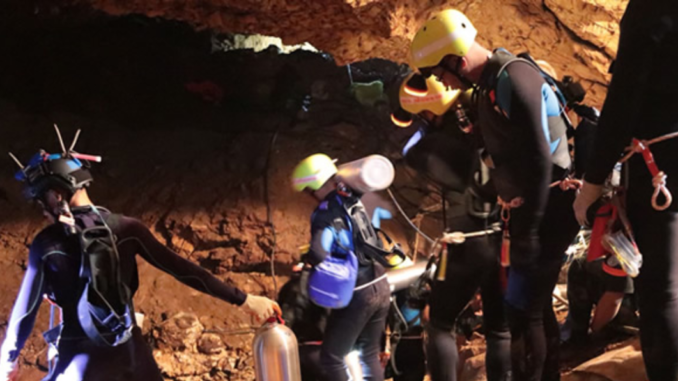
In what could easily pass for one of the most breathtaking and delicate rescue operations ever undertaken, 12 youth footballers and their 25-year-old coach were rescued on Tuesday after they had been marooned in the confines of a flooded cave system in Thailand for 18 days. Perhaps, only the Chilean rescue of 2010, in which 33 miners entombed by a crashing San Jose copper and gold mine were brought to the surface after 69 days underground, compares with this feat involving the adventurous young Thai footballers. The Chile incident was the longest in recorded history that people had spent alive buried under the ground.
Ordinarily, finding one’s way around in an environment of near-zero visibility could be very challenging, but it is even more complicated when such a place happens to be a cave with a labyrinthine network of tunnels, as in the case of the Tham Luang cave system in the Chan Rai Province of Thailand. Prone to intense flooding during the monsoon season, the cave is at some point up to 10 metres high and is known for its deep recesses and narrow passages, according to a BBC report quoting the locals.
Following nine agonising days of intense manhunt in which a worried nation – and indeed the entire world – waited with bated breath for the faintest news of assurances that the missing boys were still alive, some British divers stumbled on them on a muddy underground shelf. What a relief it was! But this relief was only the beginning of another nightmare as a more nerve-racking challenge emerged of how to bring them out of the treacherous cave.
The success of the Thailand rescue operation brought a fitting end to days of intense anxiety and emotional trauma experienced by families of the missing children and vicariously by many others in the country and across the world.
For a full adult who could swim, coming out of the flooded cave with its snaking system of caverns and crevices is no mean challenge, as can be attested to by the death of a former member of the Thai Navy SEAL, Saman Kunan. How much more kids, who had never taken a first lesson in swimming. Kunan was placing oxygen tanks in the cave preparatory to the start of the rescue when he lost his life. Challenges facing the rescuers from all parts of the world included the fast depleting level of oxygen which put the lives of the kids and rescuers in danger, as well as the imminent rise in water levels as a result of increased rainfall associated with this season.
This had forced a change of plan from providing supplies to the children while waiting for the water to recede, before rescuing them – which could take months – to embarking on immediate rescue. It also led to an alteration in initial plans of pumping millions of litres of water out of the cave while the rain was still threatening. The wisest decision was to brave the obstacles, which they did.
Consequently, in a breathtaking and meticulously choreographed operation that captivated a global audience, the first set of four children was rescued, followed by another set of four and then the last of five in an operation that lasted three days, preceded by several days of painstaking planning. It was an experience that brought to the fore the limitless possibilities of the human spirit in the face of challenges. What was initially deemed a mission impossible turned out to be a resounding success.
Just as in the case of the Chilean rescue, where the President, Sebastian Pinera, had to move his seat to the mouth of the hole drilled 2,041 feet down to where the miners were holed up, the Thai Prime Minister, Prayut Chan-o-cha, was also at the mouth of the cave to oversee the operation and empathise with the distraught parents and entire citizens. For the stretch of the 22 hours, 37 minutes that the actual rescue lasted, Pinera did not leave the site as he personally hugged every miner that emerged from the bowel of the earth.
There are important lessons inherent in the two operations, especially concerning the length to which the two leaders went to save the lives of their citizens in distress. From the rescue sight, ambulances were available to take those rescued to the hospital, after first aid had been administered. Even though they were not on government duty when the unfortunate incidents happened, they were not abandoned by their governments.
In Nigeria, the situation is sharply different. But for the very tame response that followed the kidnap of 276 Chibok schoolgirls in Borno State on April 14, 2014, for instance, maybe the girls still in captivity today might have been rescued. But the then President spent the first 19 days denying the fact of the abduction. Even the military reportedly failed to respond to distress calls made hours before the terrorists struck. Days after they had carted the girls away, there were reports of sightings of the girls by villagers. But the Nigerian state was nowhere near to give a helping hand. The same thing happens whenever there is a major national calamity; the presence of government is usually not felt.
Another important lesson that should not be lost on Nigerians is the fact that in the two cases of Chile and Thailand, assistance came from the international community. Aside from the Thai Navy SEALs that spearheaded the rescue operation, renowned divers from all parts of the world were on hand to give assistance. But in Nigeria, the government reflexively rejects foreign assistance even in places where it lacks the capacity to deal with the situation.
Things have to change. A government must always be there for the citizens; only then can their sense of patriotism be fired. Only then can they think of dying for their country when the need arises.
END

Be the first to comment